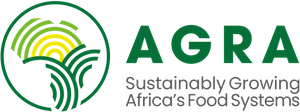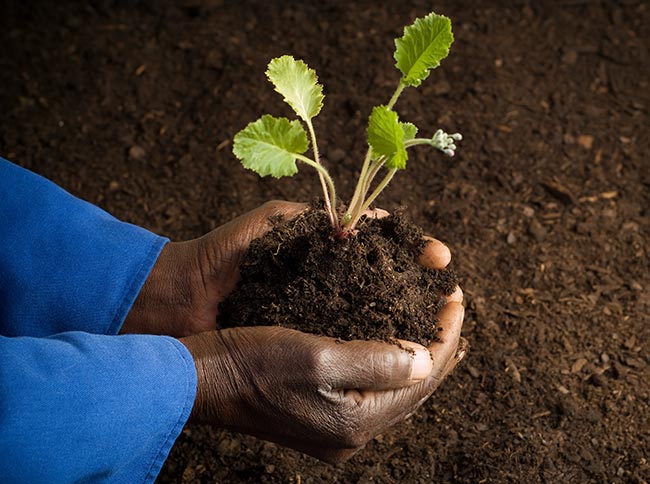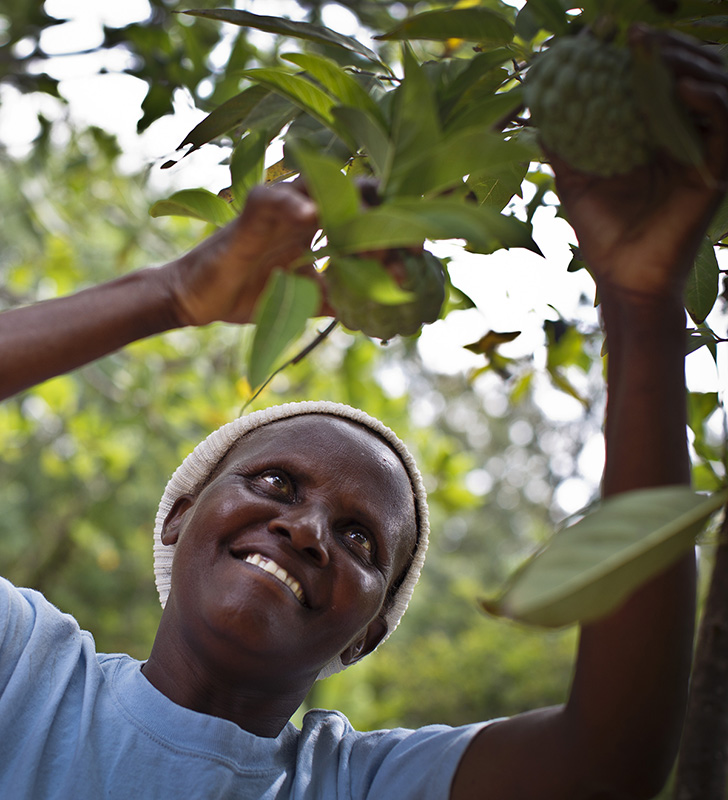Case study 1: Soybean value-added products attract markets, improve nutrition and boost farmer incomes
Western Kenya region is characterized by a high population density that exerts unprecedented pressure on the land leading to its sub-division into even smaller portions per household causing socio – economic and ecological challenges and constraints that exacerbate rural poverty. Additionally, the low application of appropriate and recommended rates of fertilizers over the years has resulted in declining agricultural productivity, farm incomes and poor household nutrition.
From 2011 to 2018 the Rural Outreach Program (ROP), a regional Non-Governmental Organization, implemented two soil health projects in western Kenya funded by AGRA to scale out maize and soybean production as well as promote value addition to their by-products for improved food security, nutrition and incomes. The impacts from these projects and the testimonies of success from the beneficiary farmers are exceedingly encouraging – fanning away the numerous socio-economic problems that the projects sought to tackle nearly a decade ago.
These challenges have been addressed through an integrated approach adopted in 2011 by the staff and partners of ROP, including AGRA, to support the smallholder farmers in the region with financial and technical support. The intervention deploys science, technology and innovation (STI) throughout the value chain to create meaningful impact for the smallholder families in the project sites.
The integrated approach to tackling soil health challenges has seen farmers in the region transform their practices from continuous land tillage without the addition of soil ameliorating inputs, to the use of blended fertilizers, lime, manure, improved seeds and good agronomic practices. This is happening not only on individual plots, but also in farms that are managed by community groups thus transforming the entire landscape. Testimonies by individual farmers and group leaders of community groups allude to the successes emanating from the ROP-led projects in transforming rural livelihoods in western Kenya.
Ms. Ann Masakhwe, a widowed mother, is one of the 13-member Emanda Adult Class Group comprising 8 females and 5 males. Located in Emanda sub location, Central Maragoli Ward, Vihiga sub-County, the group were the beneficiaries of the Integrated Soil Fertility Management (ISFM) trainings for improved food production and incomes provided by ROP in partnership with AGRA. Ms. Masakhwe narrates how she had been engaged in full-time farming activities over the last twenty years, 13 of those years on her own after her husband’s demise. She met ROP staff for the first time in 2009 when they visited Emanda Adult Class, which she leads.
Ms. Masakhwe and her farmer colleagues have never looked back since that first encounter. Applying the ISFM principles has seen the transformation of the individuals in the group from a precarious and uncertain existence to the confidence of being able to sustain their livelihoods. The memory of poverty and hunger remains in their past. Ms. Masakhwe’s 0.25 ha (1/2 acre) plot of maize, beans and indigenous vegetables could barely sustain herself and her children due to low crop yields and soil infertility, but productivity increased when she started intercropping maize with legumes especially, soybean as well as the application of organic manure and incorporating other ISFM techniques.
She recalls how she hosted the first ISFM demo site on her farm where the different treatments were show-cased – (maize pure stand, maize intercrop with soybean (soya), soya pure stand inoculated and soya pure stand not inoculated). Although the yields in the initial demo planting season were not convincing, the second season after rotational planting recorded high yields that left the farmers astounded! By the third season, Ms. Masakhwe left the demo to an affiliate group member and adopted the legume rotational cropping system. By then, her maize yields had increased from 0.5 t/ha to 2 t/ha, and beans from 0.2t/ha to 0.8 t/ha, while soybean from 0.3t/ha to t/ha. Members of her group had also adopted similar ISFM technologies and realized yield improvements, never before recorded in their area. They all confessed that they now have sufficient food for their household needs and a surplus for sale to earn them an income. Ms. Masakhwe has invested the income earned from the surplus sales in poultry rearing and a small home-based business.
The secretary of Emanda Adult Class Group says the trainings have enabled them to access farm inputs credit and adopt good agronomic practices. They also benefited from the linkages to the right input dealers as well as gaining skills for harvest and post-harvest management and value addition. The Group members also reduced the acreage under maize and increased legume and indigenous vegetable production from which they have been realizing good yields and incomes every season. The Group members value the training they received. For instance they no longer uproot the legume plants during harvest but instead cut above the soil to allow the nodules to rot and burst inside the soil and fix more nitrogen. Although part of Ms. Masakhwe’s farm was infested with the Striga hermonthica weed that used to contribute to the stunted growth of her crops, and was the cause of total crop failure in the past, she has since adopted rotation of maize and soya with the addition of organic manure on the farm, and observed a great improvement in crop yields.
In terms of value addition, Ms. Masakhwe mixes soybean flour with wheat flour to make a wide variety of delicacies. Initially she baked her cakes and scones with wheat flour alone, earning her KSh 5 (US$ 0.05) per piece at the local market. Dissatisfied at the low margins, she started mixing wheat and soybean flour. “I learned a lot of things from the ROP offices in Mbale town, and during farmers’ field days organized by ROP.” The demand for her baked goods has spiked. “I now earn double what I was getting before,” she adds with pride, “a piece of the soya value added cake or scone now sells KSh 10 (US$ 0.10) and I have to cope with meeting my clients’ demands for more.”
To illustrate how value addition has transformed her life, Ms Masakhwe recalls how she used to sell soya grain, it was only at KSh 50 (US$ 0.5) per kilogram. However, after she started using the ROP grinding machine in Mbale to process the grain into flour, her profit margins increased. She pays KSh 10 (USD 0.1) per kilogram to grind soybean into flour and sells the flour at KSh 150 (US$ 1.5) per kilogram. From the mixture of one kilogram of soya and wheat flour she is able to bake cakes and scones that sell for KSh 600 (US$ 6). She also uses the soybean flour to make soya beverage.
The adoption of ISFM technologies among farmers has led to a major social and economic transformation in the community. For instance, Ms. Masakhwe employs five assistants whom she pays on a daily basis. Three are females who assist in baking and packaging the products while two men, who operate motorbikes, distribute the cakes in the nearby towns. She has also bought land outside Vihiga County, where she has built a house and keeps two dairy cows. The income generated from her agribusinesses pays tuition fees and upkeep for her children pursuing tertiary education. Besides her farming activities she also offers other income-generating services as an adult education teacher where she serves as the sub-County Adult Education Officer in Vihiga County.
Case study 2. Empowering youth and sustaining agribusiness in Western Kenya
Youths in Western Kenya face many hurdles to earn a livelihood from farming. Land is scarce, and difficult to access especially in Vihiga County. Youths are further constrained by the lack of financial capacity, and this largely explains why landlessness among youth in Western Kenya is a primary cause of migration to urban areas to search for alternative sources of income.
The two phases of the Integrated Soil Fertility Management (ISFM) project by ROP in partnership with the Alliance for Green Revolution in Africa (AGRA) in Western Kenya (Vihiga and Kakamega Counties), worked to build the interest of youths in agricultural enterprises. The focus was on assisting the youths to generate incomes from farming, creating resilience and empowering the youths to become farming leaders in their communities. The ISFM project with support from AGRA, ICRAF and ASDSP created, strengthened and supported various youth groups to establish and manage agricultural businesses such as tree nurseries, Soya production and marketing as well as banana husbandry. It also involved training and technical assistance in the acquisition of farm inputs, good agronomy and it linked some of the groups to reliable and profitable markets.
The projects in Vihiga County supported the youth farmers in various ways including the provision of inputs like certified soya and maize seed and fertilizers provided by AGRA, tree nursery equipment for the case from ICRAF and Tissue Culture Banana seedlings from the ASDSP and County Government of Vihiga. Demonstrations on good agronomic practices and ISFM technologies were carried out on the group’s plot. They youths also received training on financial literacy through a revolving umbrella scheme, credit management and business planning and linkages to markets. Additional support was provided in assisting them in negotiations with buyers. The 15-member Ufanisi Youth Group from Mutsulyu village, Lyaduywa sub-location, Izava/Lyaduywa ward in Sabatia sub-County in Vihiga County was one of the beneficiaries of the interventions.
Kenneth Madaga Mudiali, a member of Ufanisi Youth Group comprising 9 males and 6 females, narrates how the maize and soya yields used to be very low under smallholder farmer conditions facing diverse constraints including low soil fertility, climate change, pests and diseases like the Maize Lethal Necrotic Disease (MLND) and Fall Army Worm (FAW). There was also limited use of good agronomic practices. With the training on good management, appropriate use of improved seed varieties, fertilizers, rhizobium inoculants from ROP and the County Department of Agriculture with AGRA’s support for the ISFM project, the yields doubled and profitability of maize/soya bean cropping system was realized.
Mr. Madaga observes that the increase in soybean production in his community has strengthened food and nutrition security as well as improving household incomes. He confirms that soybean plants fix the atmospheric nitrogen into the soil which improves the fertility of the soil and leads to yield improvements of other crops such as maize intercropped or rotated in the same field.
The youthful Madaga practices mixed farming, growing indigenous vegetables that he sells within the local markets around Mbale town. He has also planted Tissue Culture bananas and has acquired a dairy cow from which he obtains dung and slurry to make compost manure for his farm.
Through ROP, the youth group was supported with agro-forestry equipment from ICRAF which included the shade nets, potting bags, nursery tools and members received training on nursery management and agroforestry at the Machakos Agricultural Training Centre.
Identifying partners within a project is a strategy supported by AGRA and which ROP has embraced to link youth groups to partners may that help them and other farmers to advance their farming and entrepreneurship practices.





